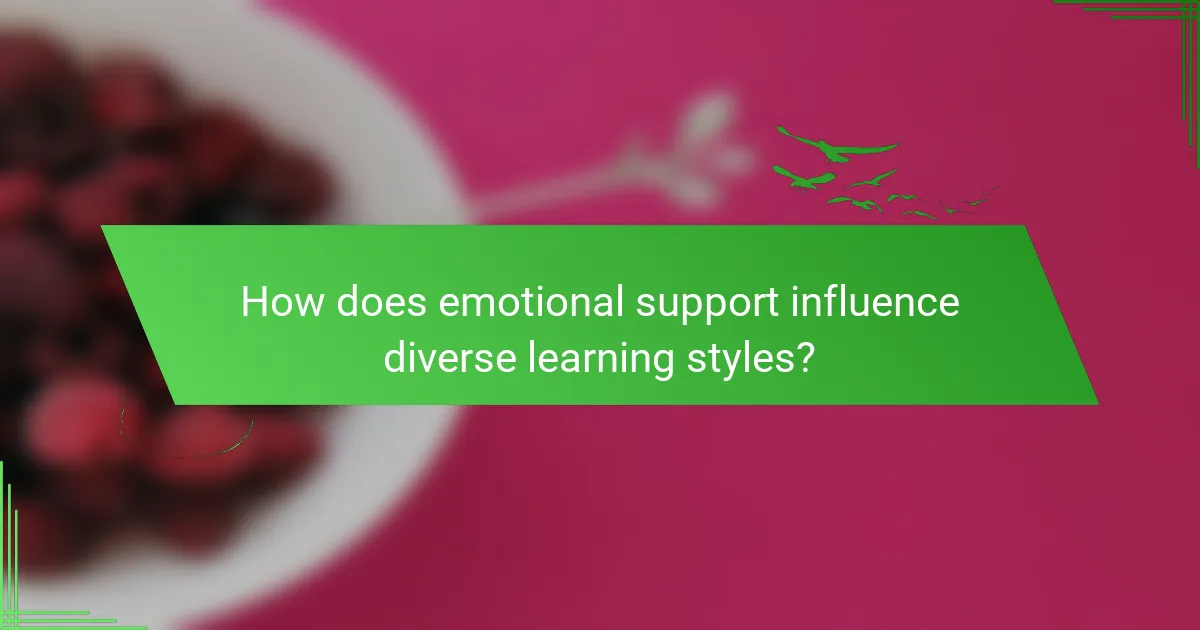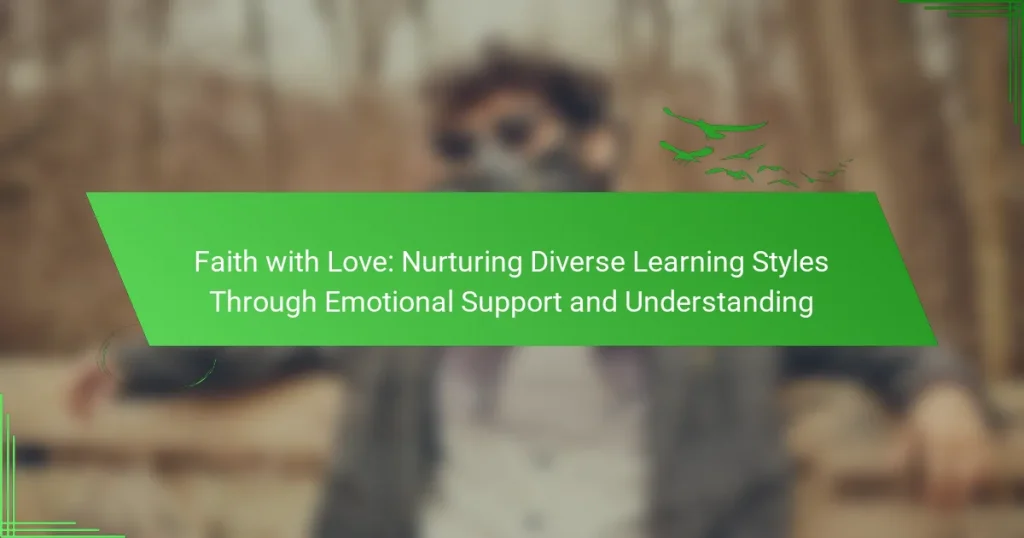Emotional support is crucial in enhancing diverse learning styles, fostering a positive educational environment. This article explores how emotional support boosts self-expression, builds trust, and promotes resilience. It discusses strategies like mindfulness practices, collaborative projects, and individualized feedback to cater to unique learning needs. By integrating emotional understanding, educators can create inclusive experiences that enhance academic performance and personal growth.

How does emotional support influence diverse learning styles?
Emotional support significantly enhances diverse learning styles by fostering a positive environment. It encourages self-expression, boosts confidence, and promotes engagement across various learning modalities. For example, students who thrive in collaborative settings benefit from emotional validation, leading to improved communication skills. Furthermore, emotional support can uniquely cater to visual, auditory, and kinesthetic learners by addressing their specific needs. As a result, the integration of emotional understanding in educational settings nurtures a more inclusive learning experience, ultimately enhancing academic performance and personal growth.
What are the key emotional needs of learners?
Key emotional needs of learners include safety, belonging, self-esteem, and self-actualization. Emotional support fosters an environment where diverse learning styles thrive. For instance, learners need to feel safe to express their thoughts without fear of judgment. A sense of belonging enhances engagement, while self-esteem boosts motivation. Lastly, self-actualization allows learners to pursue personal growth and fulfillment. Understanding these needs is crucial for effective teaching strategies.
Which learning styles benefit most from emotional understanding?
Emotional understanding significantly benefits kinesthetic and interpersonal learners. These styles thrive on emotional connections, enhancing engagement and retention. Kinesthetic learners, who learn best through hands-on experiences, benefit from emotional support that fosters a safe environment for exploration. Interpersonal learners excel in collaborative settings where emotional understanding deepens relationships and communication. By nurturing these styles with emotional insights, educators can create inclusive learning experiences that cater to diverse needs.
How can emotional support enhance visual learning?
Emotional support enhances visual learning by fostering a positive environment that boosts engagement and retention. When learners feel understood and valued, their ability to absorb visual information improves significantly. Emotional support can reduce anxiety, allowing for clearer focus on visual materials. Furthermore, it encourages collaboration, enabling learners to share insights and deepen their understanding through visual aids. This nurturing approach aligns with diverse learning styles, promoting an inclusive educational experience.
What role does emotional intelligence play in auditory learning?
Emotional intelligence significantly enhances auditory learning by fostering a supportive environment. It enables learners to connect emotionally with content, improving retention and comprehension. High emotional intelligence allows educators to tailor their approaches, addressing diverse learning styles effectively. This adaptability leads to more engaged and motivated learners, ultimately enhancing their overall educational experience.
How does kinesthetic learning thrive with emotional encouragement?
Kinesthetic learning thrives with emotional encouragement by fostering a supportive environment. Emotional support enhances motivation and engagement, crucial for kinesthetic learners who often benefit from hands-on experiences. Encouragement from educators and peers boosts their confidence, leading to improved retention and understanding of concepts. This nurturing approach aligns with the unique attribute of emotional intelligence, which plays a vital role in diverse learning styles. As a result, kinesthetic learners are more likely to explore and excel in their educational pursuits when emotionally supported.

What are the universal attributes of emotional support in education?
Emotional support in education encompasses several universal attributes that enhance learning experiences. Key attributes include empathy, active listening, trust-building, and individualized attention. These elements foster a nurturing environment that accommodates diverse learning styles. Empathy allows educators to connect with students emotionally, while active listening ensures students feel heard. Trust-building creates a safe space for expression, and individualized attention addresses unique needs. Collectively, these attributes promote resilience and academic success, ultimately leading to a holistic educational experience.
How does fostering a positive classroom environment affect learning?
Fostering a positive classroom environment significantly enhances learning outcomes. Emotional support and understanding cater to diverse learning styles, promoting engagement and retention.
A supportive atmosphere encourages collaboration among students, fostering communication skills and social development. Studies indicate that students in positive environments demonstrate higher academic performance and lower stress levels.
Unique attributes such as individualized attention and culturally responsive teaching methods further enhance this effect, addressing the specific needs of each student. As a result, educators can create a nurturing space that not only respects diversity but also inspires a love for learning.
What strategies promote emotional well-being in diverse learners?
Emotional well-being in diverse learners is promoted through strategies that emphasize understanding and support. Tailored emotional support cultivates a nurturing environment, enhancing engagement and learning outcomes.
Key strategies include fostering a sense of belonging, which can be achieved through inclusive practices that respect diverse backgrounds. Active listening encourages learners to share their feelings, while personalized feedback helps them feel valued.
Utilizing mindfulness techniques can reduce anxiety and improve focus, contributing to emotional stability. Collaboration among peers promotes social connections, further enhancing emotional resilience.
Incorporating culturally relevant materials can also validate diverse experiences, reinforcing emotional safety and support. These strategies collectively nurture emotional well-being, facilitating effective learning for all students.

What unique approaches can educators take to nurture emotional support?
Educators can nurture emotional support by employing personalized strategies that cater to diverse learning styles. One unique approach is integrating mindfulness practices into the curriculum, fostering a calm environment that promotes emotional awareness. Additionally, utilizing collaborative projects encourages peer support and enhances social connections among students. Implementing regular check-ins allows educators to understand individual emotional needs, creating a responsive learning atmosphere. Finally, incorporating creative expression through art or writing can help students articulate their feelings, enhancing emotional literacy.
How can personalized learning plans incorporate emotional understanding?
Personalized learning plans can effectively incorporate emotional understanding by recognizing individual emotional needs. This approach nurtures diverse learning styles, fostering an environment where students feel supported. Emotional intelligence enhances engagement, leading to better academic outcomes. Teachers can assess emotional states, tailoring strategies to address specific challenges. For example, incorporating mindfulness practices can improve focus and emotional regulation.
What innovative methods can be used to assess emotional needs?
Innovative methods to assess emotional needs include active listening, empathy mapping, and emotional check-ins. Active listening fosters open communication, allowing individuals to express their feelings. Empathy mapping visualizes emotional states, enhancing understanding of diverse perspectives. Emotional check-ins provide regular opportunities for individuals to reflect on their emotional well-being, ensuring ongoing support. Each method promotes a nurturing environment aligned with diverse learning styles.

What rare attributes are associated with emotional support in learning?
Emotional support in learning is associated with rare attributes such as resilience enhancement, empathy cultivation, and individualized feedback. These attributes foster a deeper connection between students and educators, promoting a supportive learning environment. Resilience enhancement helps students navigate challenges effectively. Empathy cultivation encourages understanding diverse perspectives. Individualized feedback tailors learning experiences to unique needs, maximizing engagement and retention.
How does cultural context influence emotional support strategies?
Cultural context significantly shapes emotional support strategies by influencing perceptions of empathy, communication styles, and relational dynamics. Diverse cultural backgrounds affect how individuals express and receive emotional support, creating unique approaches. For instance, collectivist cultures may prioritize group harmony and indirect communication, while individualistic cultures often emphasize direct expression of feelings. Understanding these differences fosters more effective emotional support tailored to specific cultural needs. As a result, strategies that incorporate cultural insights enhance the nurturing of diverse learning styles and emotional well-being.
What uncommon challenges do educators face in providing emotional support?
Educators face unique challenges in providing emotional support due to diverse student needs. These challenges include cultural differences, varying emotional intelligence levels, and the pressure of standardized testing. Cultural differences can lead to misunderstandings in emotional expression, making it difficult for educators to connect. Varying emotional intelligence levels among students complicate the ability to gauge their emotional needs accurately. Additionally, the pressure of standardized testing may limit the time and resources educators can dedicate to emotional support, impacting their effectiveness.

How can educators implement best practices for emotional support?
Educators can implement best practices for emotional support by fostering an inclusive environment that acknowledges diverse learning styles. They should prioritize active listening and empathy to build trust. Regular training on emotional intelligence enhances educators’ abilities to support students effectively. Incorporating social-emotional learning curricula can also provide structured frameworks for emotional support.
What common mistakes should educators avoid in addressing emotional needs?
Educators should avoid common mistakes that undermine emotional support. Ignoring individual emotional needs can lead to disengagement. Failing to establish trust may hinder student relationships. Overlooking diverse learning styles can limit effective support. Neglecting to communicate openly can create misunderstandings. Finally, not providing consistent feedback can diminish student confidence.
How can ongoing training enhance educators’ ability to support diverse learners?
Ongoing training enhances educators’ ability to support diverse learners by equipping them with strategies tailored to various learning styles. Continuous professional development fosters emotional intelligence, enabling educators to cultivate a supportive environment. This emotional support is crucial for understanding individual student needs, thereby promoting engagement and academic success. Research indicates that educators with specialized training in diversity and inclusion can significantly improve student outcomes, particularly for marginalized groups.
What actionable tips can be applied immediately to improve emotional support in the classroom?
To improve emotional support in the classroom, implement strategies that foster connection and understanding among students. Prioritize active listening to validate feelings, create a safe environment for sharing, and encourage peer support. Incorporate diverse learning styles by using varied teaching methods, such as group discussions and hands-on activities. Regular check-ins can help identify students’ emotional needs and tailor support accordingly.




